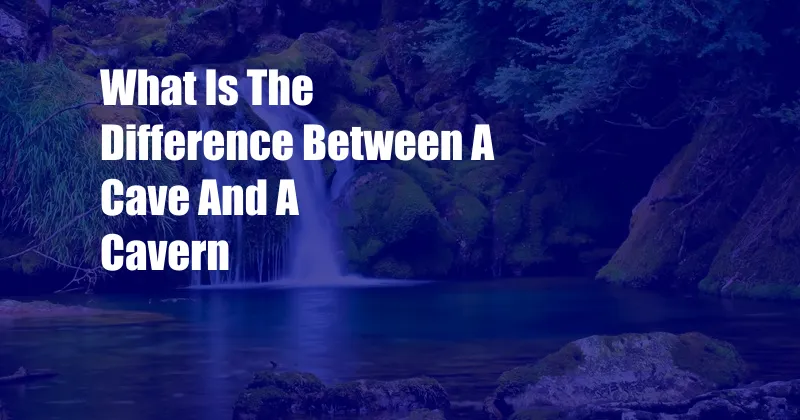
Caves vs. Caverns: Unveiling the Hidden Depths of the Earth
On a recent spelunking expedition, I found myself in a subterranean world of wonder, navigating through a labyrinth of caves and caverns. It was an awe-inspiring experience, but I couldn’t help but wonder about the subtle difference between the two. As I delved deeper into this geological mystery, I stumbled upon a treasure trove of fascinating insights, which I’m eager to share with you today.
Caves and caverns are both natural underground formations, but there are some key distinctions that set them apart. Let’s dive into the depths of these geological marvels to uncover their unique characteristics.
The Realm of Caves: A Journey into Darkness
Caves are naturally occurring voids in the earth’s crust, formed by the relentless erosion of water, ice, or other natural forces. They are characterized by their narrow passages and irregular shapes, with varying sizes and depths. Caves offer a glimpse into the hidden realms of our planet, often adorned with stunning rock formations, glistening crystals, and subterranean rivers.
The word “cave” is derived from the Latin word “cavea,” meaning “hollow place.” Caves have been used for shelter, storage, and religious purposes throughout human history, and they continue to captivate our imaginations with their geological wonders and prehistoric mysteries.
Unveiling the Wonders of Caverns: Spacious Subterranean Chambers
Caverns, on the other hand, are large underground chambers with more spacious and regular interiors compared to caves. They are often formed by the dissolution of limestone or other soluble rock by water, creating vast, cathedral-like spaces. Caverns are renowned for their impressive size and often feature intricate cave formations, such as stalactites, stalagmites, and flowstones.
The term “cavern” originates from the Latin word “caverna,” meaning “hollow.” Caverns have long been revered for their beauty and have been popular destinations for explorers, scientists, and nature enthusiasts alike.
Exploring the Roots of Caves and Caverns
The formation of caves and caverns is a complex geological process. Caves are typically formed by the erosion of soluble rocks, such as limestone, dolomite, or gypsum, by water. Over time, water seeps into cracks and fissures in the rock, gradually dissolving the rock and creating underground channels. These channels can eventually expand into larger caves.
Caverns, on the other hand, are often formed by the collapse of sinkholes or the erosion of underground rivers. Sinkholes are depressions or holes in the ground that are formed when the roof of an underground cavity collapses. Underground rivers can erode the rock around them, creating large chambers and passageways.
Cave and Cavern Evolution: A Dynamic Process
Caves and caverns are not static formations but rather undergo continuous evolution over time. Water continues to erode and shape their interiors, creating new passages and formations. Caves can also be influenced by tectonic activity, which can cause them to collapse or shift. Caverns, due to their large size, are less susceptible to collapse but can still be affected by tectonic forces.
The evolution of caves and caverns is a testament to the dynamic nature of the Earth’s geology. These subterranean wonders are constantly changing, providing a glimpse into the ongoing geological processes that shape our planet.
The Significance of Caves and Caverns
Caves and caverns have played a significant role in human history and continue to hold scientific and cultural value today. They have served as shelter, storage, and religious sites for prehistoric humans. Caves have also been used for mining, exploration, and recreation. Caverns, with their impressive size and beauty, have inspired art, literature, and music.
In addition, caves and caverns provide important habitats for a variety of plant and animal species. They offer shelter, darkness, and humidity, which are ideal conditions for many cave-dwelling organisms. Some caves and caverns also contain important paleontological and archaeological evidence, shedding light on past life and human history.
Expert Insights and Tips for Exploring Caves and Caverns
Exploring caves and caverns can be a thrilling and educational experience, but it’s essential to approach it with respect for the environment and safety precautions. Here are some tips from experienced explorers:
- Always explore with a qualified guide or experienced companion.
- Be prepared for darkness and uneven terrain. Wear appropriate clothing and footwear.
- Bring adequate lighting, such as headlamps or flashlights.
- Stay on designated trails and avoid touching or damaging formations.
- Be aware of potential hazards, such as slippery surfaces, narrow passages, and wildlife.
Frequently Asked Questions About Caves and Caverns
Q: What is the main difference between a cave and a cavern?
A: Caves are narrow, irregular underground passages, while caverns are large, spacious underground chambers.
Q: How are caves and caverns formed?
A: Caves are formed by erosion of soluble rock by water, while caverns are often formed by the collapse of sinkholes or erosion by underground rivers.
Q: Are caves and caverns safe to explore?
A: Exploring caves and caverns can be safe, but it’s crucial to follow safety precautions, including exploring with a guide, wearing appropriate gear, and being aware of potential hazards.
Conclusion
Caves and caverns are fascinating geological wonders that offer a glimpse into the hidden depths of our planet. While they share the common characteristic of being subterranean formations, they exhibit distinct differences in size, shape, and origin. As we continue to explore and appreciate these subterranean marvels, let us do so with respect for their delicate ecosystems and the awe-inspiring beauty they behold.
Are you captivated by the mysteries of caves and caverns? Share your thoughts and experiences in the comments below.